
Protea cynaroides, also called the king protea, is a flowering plant. It is a distinctive member of Protea, having the largest flower head in the genus. The species is also known as giant protea, honeypot or king sugar bush. It is widely distributed in the southwestern and southern parts of South Africa in the fynbos region.

Cypress is a common name for various coniferous trees or shrubs of northern temperate regions that belong to the family Cupressaceae. The word cypress is derived from Old French cipres, which was imported from Latin cypressus, the latinisation of the Greek κυπάρισσος (kyparissos).

Gloriosa is a genus of 12 species in the plant family Colchicaceae, and includes the formerly recognised genus Littonia. They are native in tropical and southern Africa to Asia, and naturalised in Australia and the Pacific as well as being widely cultivated. The most common English names are flame lily, fire lily, gloriosa lily, glory lily, superb lily, climbing lily, and creeping lily.
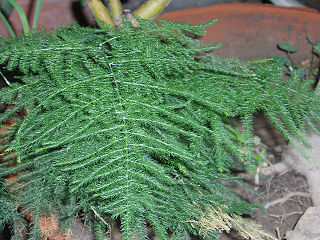
Asparagus is a genus of flowering plants in the family Asparagaceae, subfamily Asparagoideae. It comprises up to 300 species. Most are evergreen long-lived perennial plants growing from the understory as lianas, bushes or climbing plants. The best-known species is the edible Asparagus officinalis, commonly referred to as just asparagus. Some other members of the genus, such as Asparagus densiflorus, are grown as ornamental plants.

Crinum is a genus of about 180 species of perennial plants that have large showy flowers on leafless stems, and develop from bulbs. They are found in seasonally moist areas, including marshes, swamps, depressions and along the sides of streams and lakes in tropical and subtropical areas worldwide.

Hyphaene is a genus of palms native to Africa, Madagascar, the Middle East, and the Indian subcontinent.

Olea is a genus of about 40 species in the family Oleaceae, native to warm temperate and tropical regions of the Middle East, southern Europe, Africa, southern Asia, and Australasia. They are evergreen trees and shrubs, with small, opposite, entire leaves. The fruit is a drupe. Leaves of Olea contain trichosclereids.

Washingtonia is a genus of palms, native to the southwestern United States and northwest Mexico. Both Washingtonia species are commonly cultivated across the Southern United States, the Middle East, southern Europe, and North Africa, where they have greatly hybridized.
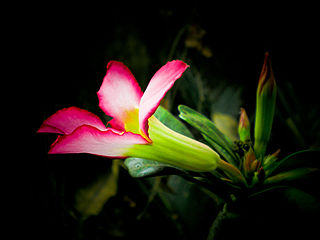
Adenium is a genus of flowering plants in the family Apocynaceae first described as a genus in 1819. It is native to Africa and the Arabian Peninsula.

Lanaria is a monotypic genus of flowering plants containing a single species, Lanaria lanata, endemic to the southern coast of South Africa where it is associated with the fynbos belt. Lanaria lanata is commonly known as Cape edelweiss or lambtails. The genus is placed in the monotypic family Lanariaceae, a family only recently recognized by taxonomists. The APG IV system of 2016 does recognize this family.
The World Geographical Scheme for Recording Plant Distributions (WGSRPD) is a biogeographical system developed by the international Biodiversity Information Standards (TDWG) organization, formerly the International Working Group on Taxonomic Databases. The WGSRPD standards, like other standards for data fields in botanical databases, were developed to promote "the wider and more effective dissemination of information about the world's heritage of biological organisms for the benefit of the world at large". The system provides clear definitions and codes for recording plant distributions at four scales or levels, from "botanical continents" down to parts of large countries. Current users of the system include the International Union for Conservation of Nature (IUCN), the Germplasm Resources Information Network (GRIN), and the World Checklist of Selected Plant Families (WCSP).

The wildlife of South Africa consists of the flora and fauna of this country in southern Africa. The country has a range of different habitat types and an ecologically rich and diverse wildlife, vascular plants being particularly abundant, many of them endemic to the country. There are few forested areas, much savanna grassland, semi-arid Karoo vegetation and the fynbos of the Cape Floristic Region. Famed for its national parks and big game, 297 species of mammal have been recorded in South Africa, as well as 858 species of bird and over 20,000 species of vascular plants.

Dierama is a genus of flowering plants in the family Iridaceae. Common names include hairbells, angel's fishing rod, fairybells, and wandflowers in English and grasklokkies in Afrikaans. They are native to Africa, with most occurring in the southern regions of the continent. The center of diversity is the province of KwaZulu-Natal in eastern South Africa.
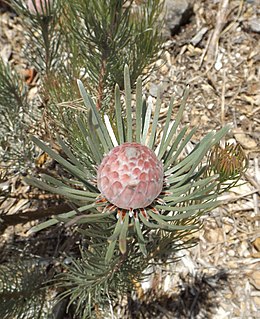
Leucadendron album is a species of flowering plant in the family Proteaceae that grows in South Africa.

Holarrhena pubescens is a species of flowering plant in the family Apocynaceae. It is native to central and southern Africa, the Indian Subcontinent, Indochina, and parts of China. In Cambodia, it is called /tɨk dɑh kʰlaː thɔm/ ទឹកដោះខ្លាធំ big tiger milk or /kʰlaɛɲ kŭəŋ/ ខ្លែងគង់ invulnerable kite. These seeds are sold as indraja (इनद्राजा) for Ayurvedic medicine in India.

Protea roupelliae is a species of Protea in the large family Proteaceae, and was named to commemorate Arabella Elizabeth Roupell (1817-1914) who spent two years in Cape Town and painted local flowers for her own pleasure.
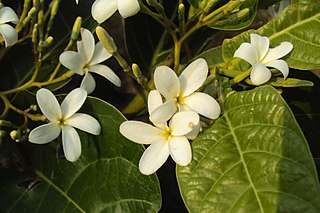
Holarrhena is a genus of plant in the family Apocynaceae first described as a genus in 1810. It is native to tropical and southern Africa as well as south, east, and southeast Asia. As of August 2013 the World Checklist of Selected Plant Families recognises 5 species:

Schrebera is a genus of plant in the family Oleaceae found in Peru, tropical and southern Africa, India and Southeast Asia. As of September 2013 the World Checklist of Selected Plant Families recognises 8 species:
Plants of the World Online is an online database published by the Royal Botanic Gardens, Kew. It was launched in March 2017 with the ultimate aim being "to enable users to access information on all the world's known seed-bearing plants by 2020". The initial focus was on tropical African Floras, particularly Flora Zambesiaca, Flora of West Tropical Africa and Flora of Tropical East Africa.
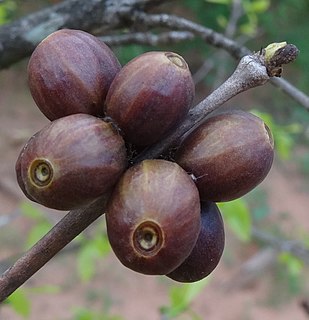
Coffea racemosa, also known as racemosa coffee and Inhambane coffee, is a species of flowering plant in the family Rubiaceae. It has naturally low levels of caffeine, less than half of that found in Coffea arabica, and a quarter of that in Robusta coffee. It is endemic to the coastal forest belt between northern KwaZulu-Natal in South Africa and Zimbabwe, found in an area less than 150 km2 (58 sq mi) in size. It was widely cultivated by the Portuguese during the 1960-1970s in Mozambique, currently there are only two plantations at Ibo Island and in Hluhluwe, which remain.


















